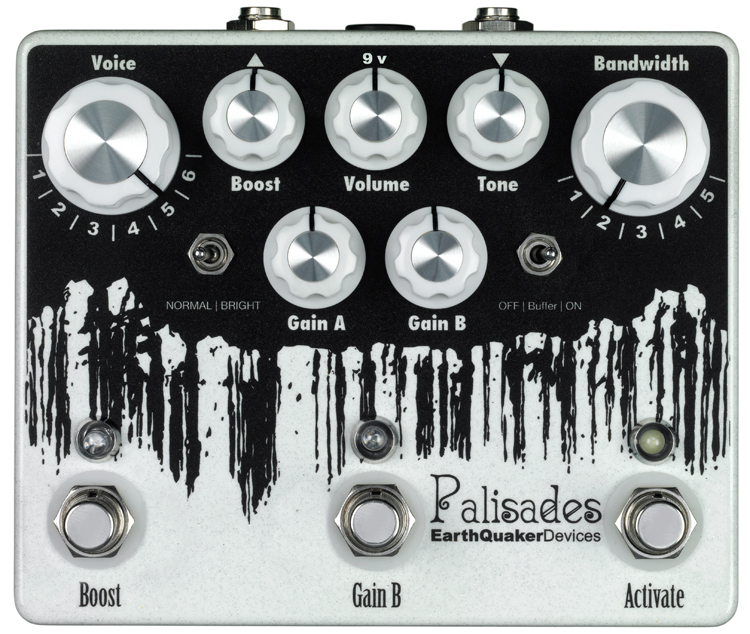 Palisades Mega Ultimate Maximum Overdrive
Palisades Mega Ultimate Maximum Overdrive
EarthQuaker Devices, based in Akron OH, a manufacturer of hand-built guitar effect pedals that’s been wowing its devoted fans since 2004, creates devices that represent a diverse assortment of categories, which range from boost/EQ and compression to delay/reverb and fuzz, plus modulation, octave and overdrive. The company ensures its success not only through its expertise crafting exceptional pedals but also by listening to its customers and delivering the products they demand. The Palisades Mega Ultimate Maximum Overdrive (MAP: $249.95) is a prime example. Jamie Stillman, President of EarthQuaker Devices, remarked, “We had received a lot of requests over the years for a Tube Screamer-styled overdrive, but we’d never really had anything that fit the bill. I was never a fan of any TS-styled pedal I had tried. But, since we were receiving so many inquiries, I figured I should maybe go back and revisit the pedal.” As it turned out, that decision was an auspicious one.
“I don’t know what I was hearing all those years,” Stillman continued, “but, now, I really like the mid bump and note clarity you get from a stock Ibanez TS808.” Because the boutique pedal market is flooded with TS-based overdrives, Stillman set out to make a unique finished product. The first step was procuring several TS-based overdrives, plus a vintage TS808 and a reissue TS9, to see what they had to offer. “I did a lot of Internet research to see what mods people liked and what had been done to death,” he added. Then, he spent about six months with the circuit on the breadboard.
“I started with the basic TS808 circuit and went from there,” Stillman revealed. He began by experimenting with the EQ section. “Although I liked the mid bump, I wanted to flatten it out a bit and allow more bass to pass through,” he explained. “That’s where the ‘bandwidth’ control came into play. I found so many settings that I decided to add a rotary switch to choose anything from a tiny, thin setting through to a full-on bass, heavy setting.” Then, he experimented with different diode combinations. “The diodes make all the difference with compression, output, clipping styles, harmonics and the general feel of the circuit,” Stillman emphasized. “There were actually quite a few combos I liked a lot, but I decided to stick with the ones on the production model because they had the most even shift between settings and offered pretty much anything I’d want.”
Then, Stillman experimented with op amps, bringing in about 25 different ones and spending weeks listening for major differences. “I settled on the LM833,” he explained, “because it had a little less background noise than all the others in this particular circuit.” The final stages were adding the bright switch, buffer switch, second gain channel and a post boost. “Those were all decisions I made after trying out the circuit in a live setting,” Stillman noted. The resulting product, the Palisades, a TS808-styled overdrive, arguably exceeds all other pedals based on the circuit. Whether a player wants thin and clean or fat and heavy, it’s all available with adjustable bandwidth and voice controls.
Some TS variants offer three clipping options, but Stillman wanted more, employing the rotary switch to choose between them. “Option 1 is no diodes,” he explained. “It gives the loudest and least clipped signal. It’s good for people who use the TS as a boost.” He continued, explaining, “Option 2 is LED clipping, which has been quite popular in the past. It still gives a lot of volume, but adds a little hair. Option 3 is MOSFET clipping…another popular clipping style. To me, this setting sounds the most like a Marshall amp: good crunch with nice harmonics. Option 4 is asymmetrical silicon diodes. It has kind of a ‘clean gain’ type feel. Option 5 is symmetrical silicon diodes. It’s similar to asymmetrical, but has a tighter feel and works well with palm muting. Option 6 is Schottky diode clipping, which has an almost fuzz-like quality to it.” Going up the dial, each of these diode groups clips the signal a little more.
The bandwidth control completely changes the characteristics of the diode clipping and what frequencies are allowed to pass. “At Setting 1,” Stillman began, “it allows very little clipping in almost all the voice settings and allows very little bass to pass through.” He continued, “As you turn the bandwidth up, it starts to clip more of the upper frequencies and allows more bass to pass through.” Setting 3 on the bandwidth and Option 4 on the voice, he said, is as close to an actual TS808 as the Palisades gets. Summarizing, Stillman stated, “I changed a lot of things, taking it away from being a straight-up TS clone with clipping and tone options. It won’t nail a TS808 perfectly, but it’ll get close while still remaining unique.”
Also setting the Palisades apart are its two gain channels and foot switchable volume boost. According to Stillman, “The channel switch is literally switching between two pots; nothing else in the circuit changes.” He added, “I found myself always using two or more overdrive pedals to go from my main tone to a heavier, distorted tone in loud sections of songs or to boost lead lines. The two gain channels and boost seemed like a no-brainer to me and knocked three pedals off my board!”
In what is likely a surprise to no one, the response thus far to the Palisades has been overwhelmingly positive; people love it. According to Stillman, “We get a lot of comments on how it has freed up space on pedal boards by knocking off two or three other overdrive and boost pedals. A lot of people have gotten a lot of use out of all the options in the studio, as well.”
The Palisades, shipping now, would be a welcome addition to your shelves.
[maxbutton id=”17″]


